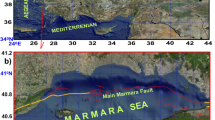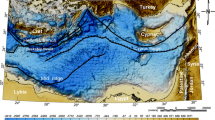Abstract
The main target of this work was to study the dynamics of the Earth’s crust for Egypt based on the magnetic survey. High-resolution land magnetic data were analyzed, combined with the results of GPS and seismic stress analyses.
The constructed tectonic map shows that the N35°-N45°W trend of the structure (related to the Red Sea and Gulf of Suez tectonics) predominates along the Gulf of Suez, Red Sea, covering wide parts of the study area. The N45°-N65°E tectonic trend (related to the Syrian Arc tectonics), prevailing in the northern part of Egypt, is of the second rank. The Aqaba (N15°-25°E) and E-W trends prevail in the northern part and along the transition zone of stable/unstable shelves. The depth to the basement rocks ranges from the surface along the Red Sea and southern parts of Egypt to more than 4 km below sea level at the northern part of the study area.
The results also show that the opening rate along the Red Sea was faster in the past than nowadays. Furthermore, a preliminary kinematics model is proposed.
Similar content being viewed by others
References
Abu El Enean, K.M. (1997), A study on the seismotectonics of Egypt in relation to the Mediterranean and Red Seas tectonics, Ph.D. Thesis, Faculty of Science, Ain Shams University, Cairo, Egypt, 200 pp.
Agocs, W.B., A.A. Meyerhoff, and K. Kis (1992), Reykjanes ridge: Quantitative determinations from magnetic anomalies. In: S. Chatterjee and N. Hotton III (eds.), New Concepts in Global Tectonics, Texas Techn. University Press, Lubbock, TX, 221–238.
Badawy, A., and F. Horv’ath (1999), The Sinai subplate and tectonic evolution of the northern Red Sea region, J. Geodynamics 27, 4–5, 433–450, DOI: 10.1016/S0264-3707(98)00023-4.
Baranov, V. (1975), Potential fields and their transformations in applied geophysics, Geoexploration Monographs, Ser. L-6, Gebruder Borntraeger, Berlin.
Beydoun, Z. (1999), Evaluation and development of the Levant (Dead Sea Rift) transform system: A historical-chronological review of a structural controvery. In: C. Macniocaill and P.D. Rayn (eds.), Continental Tectonic, Geological Society, London, Special Publs. 164, 239–255.
Chaimov, T.A., M. Barazangi, D. Al-Saad, T. Sawaf, and A. Gebran (1990), Crustal shortening in the Palmyride fold belt, Syria, and implications for movement along the Dead Sea fault system, Tectonics 9, 6, 1369–1386, DOI: 10.1029/TC009i006p01369.
Geosoft Oasis montaj (2004), Software for Earth mapping and exploration, Ver. 6.0, Geosoft Company, Toronto, Canada.
GM-SYS (1995), Gravity and magnetic modelling, Ver. 3.6, Northwest Geophysical Association (NGA), Corvallis, OR.
Grant, F.S., and G.F. West (1965), Interpretation Theory in Applied Geophysics, MacGraw-Hill, New York.
Grauch, V.J.S., M.R. Hudson, and S.A. Minor (2001), Aeromagnetic expression of faults that offset basin fill, Albuquerque basin, New Mexico, Geophysics 66, 3, 707–720, DOI: 10.1190/1.1444961.
Khalil, H., M. Becker, S.M. Abdel Monem, K. Sakr, A. Al Aydrus, H. Hussain, Abou Elenean, A. Kamel, S. Mahmoud, and Ali Rayan (2006), Geodynamical studies in the near east Mediterranean and Red Sea regions using GPS and seismological data analysis, Proc. 4th Intern. Symp. Geophys., Tanta, 317–339.
Kopp, H., and N. Kukowski (2003), Backstop geometry and accretionary mechanics of the Sunda margin, Tectonics 22, 6, 1072, DOI: 10.1029/2002TC001420.
LePichon, X., J. Francheteau, and J. Bonnin (1976), Developments in Tectonics (Plate Tectonics), 2nd ed., Vol. 6, Elsevier, Amsterdam, 300 pp.
Linsser, H. (1967), Investigation of tectonics by gravity detailing, Geophys. Prosp. 15, 3, 480–515, DOI: 10.1111/j.1365-2478.1967.tb01800.x.
Lyberis, N. (1988), Tectonic evolution of the Gulf of Suez and the Gulf of Aqaba, Tectonophysics 153, 1–4, 209–220, DOI: 10.1016/0040-1951(88)90016-9.
Mahmoud, S.M. (2005), Monitoring the crustal deformation in Egypt using GPS technique in ITRF reference frame, Proc. FIG Working Week 2005 and GDSI-8, 16-21 April, Cairo, Egypt.
Matthias, B., B. Carine, and F. Rui (on behalf of Wegener Directory Board) (2002), Processing and submission guidelines for GPS solutions to be integrated to a Wegener data base, Universitat der Bundeswehr, Munchen Fakultaet fuer Bauingenieur und Vermessungen - Institut fuer Geodaesie.
McClusky, S., R. Reilinger, S.M. Mahmoud, D. Ben Sari, and A. Tealeb (2003), GPS constraints on Africa (Nubia) and Arabia plate motions, Geophys. J. Int. 155, 1, 126–138, DOI: 10.1046/j.1365-246X.2003.02023.x.
Oreskes, N. (ed.) (2003), Plate Tectonics: An Insider’s History of the Modern Theory of the Earth, Westview Press, Boulder.
Ott d’Estevou, P., J.J. Jarrige, C. Montenat, and J.P. Richert (1989), Succession des paléochamps de contrainte et évolution du Golfe de Suez et de la Mer Rouge nord-occidentale (Égypte), Bull. Centres Rech. Explor.-Prod. Elf-Aquitaine, Pau 13, 2, 297–318.
Patton, T.L., A.R. Moustafa, R.A. Nelson, and S.A. Abdine (1994), Tectonic evaluation and structural setting of the Suez Rift. In: S.M. Landon (ed.), Interior Rift Basins, Amer. Assoc. of Petroleum Geologist, Memoir 59, 7–55.
Quennell, A.M. (1958), The structural and geomorphic evidence of the Dead Sea rift, Quart. J. Geol. Soc. London 114, 1–24.
Rabeh, T., and M. Miranda (2008), A tectonic model of the Sinai Peninsula based on magnetic data, J. Geophys. Eng. 5, 4, 469–479, DOI: 10.1088/1742-2132/5/4/010.
Reid, A.B., J.M. Allsop, H. Granser, A.J. Millett, and I.W. Somerton (1990), Magnetic interpretation in three dimensions using Euler deconvolution, Geophysics 55, 1, 80–91, DOI: 10.1190/1.1442774.
Reilinger, R., S. McClusky, A. ArRajehi, S. Mahmoud, A. Rayan, W. Ghebreab, G. Ogubazghi, and A. Al-Aydrus (2006), Geodetic constraints on rupturing of continental lithosphere along the Red Sea, Margins Newsletter 17, 17–21.
Said, R. (1962), The Geology of Egypt, Elsevier Publishing Co., Amsterdam - New York.
Said, R. (1990), The Geology of Egypt, Balkema Publishers, Rotterdam, 734 pp.
Thompson, D.T. (1982), EULDPH - A new technique for making computer-assisted depth estimates from magnetic data, Geophysics 47, 1, 31–37, DOI: 10.1190/1.1441278.
U.S. Geological Survey (1998), Open-File Report 99-50-A, U.S. Geological Survey, Denver, Colorado, World Energy Project, October 1998.
Author information
Authors and Affiliations
Corresponding author
Rights and permissions
About this article
Cite this article
Rabeh, T., Ernst, T. Tectonic model of Egypt based on magnetic analysis. Acta Geophys. 57, 680–695 (2009). https://doi.org/10.2478/s11600-009-0013-x
Received:
Accepted:
Published:
Issue Date:
DOI: https://doi.org/10.2478/s11600-009-0013-x




